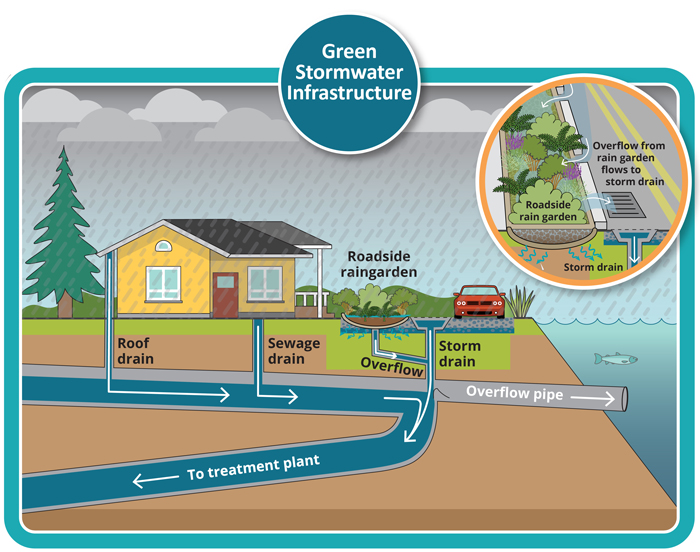Natural drainage solutions to Protect Our Waters
King County uses natural drainage to keep stormwater from entering the combined sewer system.

Drainage solutions that use plants, trees, and soil to soak up the rain are called green stormwater infrastructure (GSI) or natural drainage. These solutions are different from traditional infrastructure solutions that use pipes, underground storage tanks, and treatment plants to collect and clean the water.
Natural drainage allows stormwater to soak into the earth, the way it did before Seattle was developed. This reduces the risk of combined sewer overflows (CSOs) on rainy days, the cost and size of traditional facilities required to control CSOs, and neighborhood impacts.
To meet our regulators' requirements for CSO control, GSI/natural drainage projects must:
- Remove enough stormwater from the wastewater system. Otherwise, traditional solutions may also be needed.
- Have enough land for rain gardens and other elements. Good locations include planting strips, and parking lots.
- Have appropriate soils and flat areas where water can seep into the ground. Steep slopes and poorly draining soils are not recommended for these techniques.
GSI/Natural drainage techniques
GSI/Natural drainage systems manage stormwater by allowing it to soak into the ground or evaporate into the air. There are a number of ways to do this on streets and on private property:
- Roadside rain gardens are low areas that absorb large amounts of stormwater from streets and sidewalks. They are planted with deep-rooted plants and grasses. These gardens temporarily hold and clean stormwater. The water soaks into the ground, evaporates, or slowly drains into the sewer system after a storm has passed. They are often located in parking lots, median strips, or planter strips in residential neighborhoods.
- Permeable pavement is hard but porous material that allows stormwater to soak through into the ground below. Bicycles and cars can travel on permeable pavement.
- Cisterns and rain barrels store rain to reduce the amount of water entering the sewer system. In the summer, this water can be used for watering.
- Green roofs are made of shallow layers of soil, low-growing vegetation, subsurface drainage, and a waterproof membrane. They look natural while slowing stormwater.
- Tree boxes are street trees designed to store and filter stormwater. They work well in small spaces and provide multiple benefits including reducing air pollution and absorbing carbon dioxide.
Learn more about natural drainage projects in Seattle
Landscape choices people and businesses can make
People can use these GSI/natural drainage techniques in their businesses and homes too. Some property owners can get a RainWise rebate that will pay for these features.

 Translate
Translate